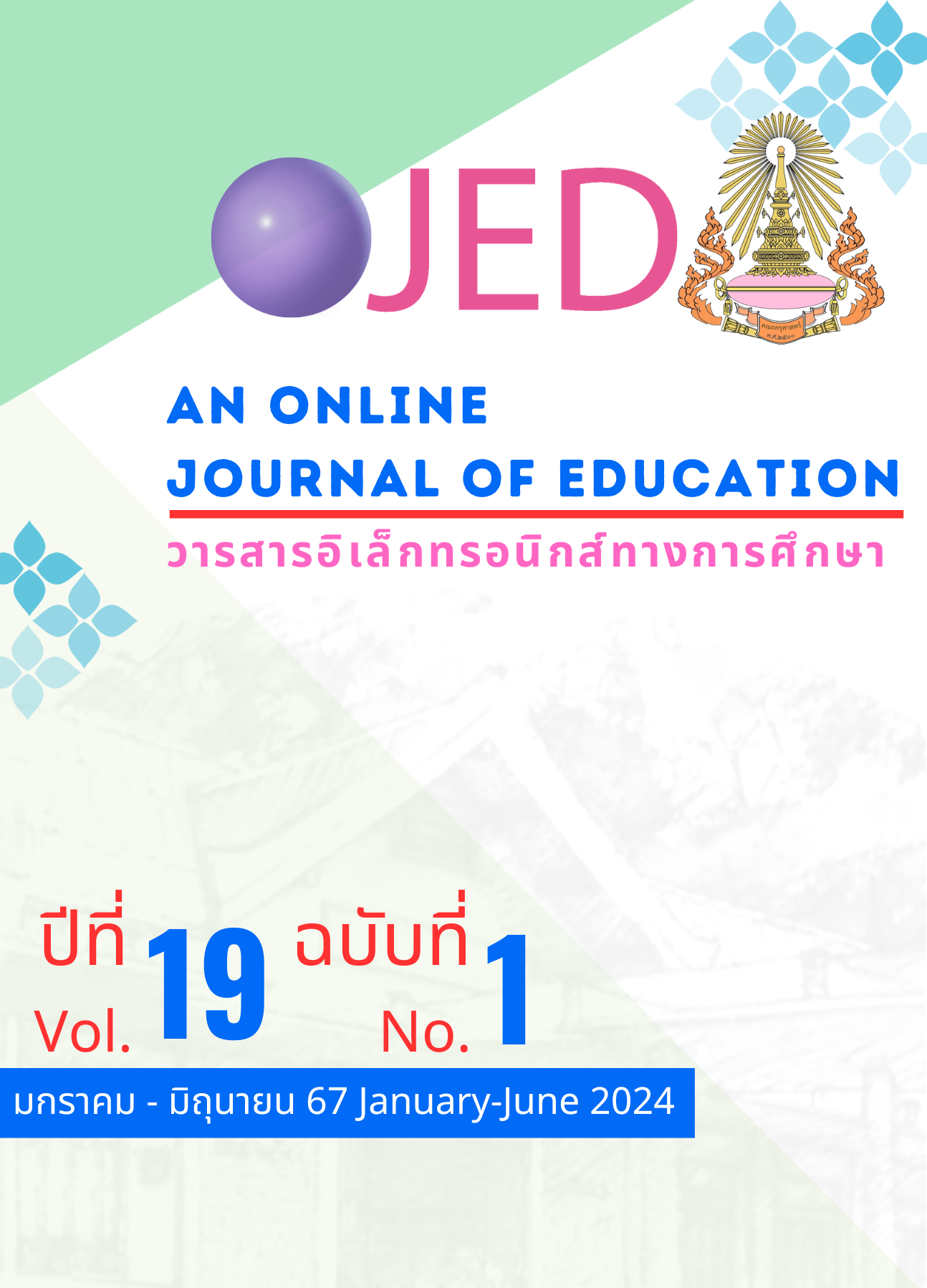A Study of the Needs and Use of Information Technology to Enhance Cyber security Awareness of Elementary Students
DOI:
https://doi.org/10.14456/ojed.2024.11Keywords:
mobile applications, awareness, cybersecurity, needs assessment, information technologyAbstract
The aims of this study were to: 1) explore current information technology usage among elementary students 2) study the user experience of mobile applications, and 3) identify the requirements of mobile applications to enhance cybersecurity awareness among elementary students. The sample group consisted of 400 upper elementary students. The research tool consisted of a questionnaire comprising checklist, ranking, and rating scale questions. Data were analyzed using frequency, percentage, mean, and standard deviation. The Modified Priority Need Index (Modified PNI) technique was utilized to prioritize needs. The research revealed the following insights 1) most elementary students used Android mobile phones to access the Google Chrome browser, 2) the overall user experience of mobile applications was rated at a high level, with setting a password to secure mobile applications having the highest average score, and 3) the need for mobile applications to enhance cybersecurity awareness among elementary students as a whole was determined to be at a high level. Thus, using technology in everyday life has the highest index of needs, followed by the use of technology for learning, and the use of social media, respectively.
References
ภาษาไทย
กระทรวงศึกษาธิการ. 2546. พระราชบัญญัติการการศึกษา พ.ศ. 2542 และที่แก้ไขเพิ่มเติม (ฉบับที่ 2) พ.ศ. 2545. กรุงเทพฯ: โรงพิมพ์คุรุสภาลาดพร้าว.
กาญจนาภา วัฒนธรรม และ จินตวีร์ คล้ายสังข์. (2564). การศึกษาการใช้เทคโนโลยีสารสนเทศความต้องการจำเป็นและปัจจัยที่ส่งผลต่อการใช้โมไบล์แอปพลิเคชันเพื่อส่งเสริมทักษะฟัง-พูด ภาษาจีนของนักเรียนระดับชั้นมัธยมศึกษา. Journal of Educational Technology and Communications Faculty of Education Mahasarakham University (JETC), 4(12), 7-18.
คริชณะ ฉิมมณี, สุภาพร พันธ์ยา และ ราชศักดิ์ สมยานนทนากุล. (2566). การตระหนักรู้เท่าทันภัยคุกคามจากการใช้อินเทอร์เน็ต: กรณีจำลองการโจมตีด้วยการคาดเดารหัสผ่าน (Password Attack). วารสารวิชาการนวัตกรรมสื่อสารสังคม, 11(1), 165-171.
ชโรชีนีย์ ชัยมินทร์. (2023). ทักษะการรู้เท่าทันสื่อสำหรับเด็กและเยาวชนเพื่อส่งเสริมความเป็นพลเมืองดิจิทัล. วารสารห้องสมุดสมาคมห้องสมุดแห่งประเทศไทยฯ, 67(1), 21-39.
ฐิติมา ภู่ห้อย. (2564) การสร้างกรอบวัฒนธรรมความมั่นคงปลอดภัยไซเบอร์ในองค์กรสำหรับการเปลี่ยนผ่านทางความมั่นคงปลอดภัยไซเบอร์ [วิทยานิพนธ์ปริญญาดุษฎีบัณฑิต]. มหาวิทยาลัยศรีปทุม
พระราชบัญญัติการรักษาความมั่นคงปลอดภัยไซเบอร์ พ.ศ.2562. (2562, 27พฤษภาคม). ราชกิจจานุเบกษา, 136(69ก), 20-51.
พรพิมล รอดเคราะห์. (2564). แนวทางการจัดการเรียนการสอนที่ส่งเสริมการใช้เทคโนโลยีสารสนเทศและการสื่อสารอย่างมีคุณธรรมจริยธรรมสำหรับนักเรียนชั้นประถมศึกษา. วารสารบัณฑิตศึกษา มหาวิทยาลัยราชภัฏวไลยอลงกรณ์ ในพระบรมราชูปถัมภ์, 14(3), 241-260.
ภิญโญ วงษ์ทอง (2564). การจัดการเรียนรู้ออนไลน์บนฐานวิถีชีวิตใหม่สำหรับนักเรียนระดับชั้นประถมศึกษาตอนปลาย. วารสารรัชต์ภาคย์, 15(43), 101-117.
สุวิมล ว่องวานิช. (2550). การวิจัยประเมินความต้องการจำเป็น (พิมพ์ครั้งที่ 2). สำนักพิมพ์แห่งจุฬาลงกรณ์มหาวิทยาลัย.
ภาษาอังกฤษ
Acquah, E. O., & Katz, H. T. (2020). Digital game-based L2 learning outcomes for primary through high-school students: A systematic literature review. Computers & Education, 143, 103667. https://doi.org/10.1016/j.compedu.2019.103667
Alharbi, T., & Tassaddiq, A. (2021). Assessment of Cybersecurity Awareness among Students of Majmaah University. Big Data and Cognitive Computing, 5(2), 23. https://doi.org/10.3390/bdcc5020023
Barth, S., de Jong, M. D. T., & Junger, M. (2022). Lost in privacy? Online privacy from a cybersecurity expert perspective. Telematics and Informatics, 68, 101782. https://doi.org/10.1016/j.tele.2022.101782
Corallo, A., Lazoi, M., Lezzi, M., & Luperto, A. (2022). Cybersecurity awareness in the context of the Industrial Internet of Things: A systematic literature review. Computers in Industry, 137, 103614. https://doi.org/10.1016/j.compind.2022.103614
Cronbach, L. J. (1990).Essentials of Psychological Testing (5th ed.).New York : Harper Collins Publishers.
( pp.202-204).
Fong, B. Y. F., Yee, H. H. L., NG, T. K. C., & Law, V. T. S. (2022). The use of technology for online learning among older adults in Hong Kong. International Review of Education, 68(3), 389–407. https://doi.org/10.1007/s11159-022-09957-7
Jha, A. K. (2020). Understanding Generation Alpha. OSF Preprints, 1-10. https://doi.org/10.31219/osf.io/d2e8g
Khan, M. A., Merabet, A., Alkaabi, S., & Sayed, H. E. (2022). Game-based learning platform to enhance education. Education and Information Technologies, 27, 5153–5177. https://doi.org/10.1007/s10639-021-10807-6
Kovačević, A., Putnik, N., & Tošković, O. (2020). Factors related to cyber security behavior. IEEE Access, 8, 125140-125148.
Krejcie, R. V., & Morgan, D. W. (1970). Determining sample size for research activities. Educational and Psychological Measurement, 30(3), 607–610. https://doi.org/10.1177/001316447003000308
Liew, K. F., Lam, W. S., Lam, W. H., & Teh, K. X. (2023). Evaluation of the preference of web browsers among undergraduates using AHP-TOPSIS model. In Shakya, S., Balas, V.E., Haoxiang, W. (Eds.), Proceedings of Third International Conference on Sustainable Expert Systems, Lecture Notes in Networks and Systems: Vol. 587. (pp. 851–861). Springer, Singapore. https://doi.org/10.1007/978-981-19-7874-6_62
Quayyum, F., Cruzes, D. S., & Jaccheri, L. (2021). Cybersecurity awareness for children: A systematic literature review. International Journal of Child-Computer Interaction, 30(1), 100343. https://doi.org/10.1016/j.ijcci.2021.100343
Triplett, W. J. (2023). Addressing cybersecurity challenges in education. International Journal of STEM Education for Sustainability, 3(1), 47-67. https://doi.org/10.53889/ijses.v3i1.132
Witsenboer, J. W. A., Sijtsma, K., & Scheele, F. (2022). Measuring cyber secure behavior of elementary and high school students in the Netherlands. Computers & Education, 186, 104536. https://doi.org/10.1016/j.compedu.2022.104536
Xu, S. (2020, November). The Cybersecurity Dynamics Way of Thinking and Landscape [Paper presentation]. the 7th ACM Workshop on Moving Target Defense (MTD'20), New York, NY, USA. https://dl.acm.org/doi/pdf/10.1145/3411496.3421225
Downloads
Published
How to Cite
Issue
Section
License
Copyright (c) 2024 An Online Journal of Education

This work is licensed under a Creative Commons Attribution-NonCommercial-NoDerivatives 4.0 International License.




